The New Strato cab isn't as roomy as some, but
Page 37
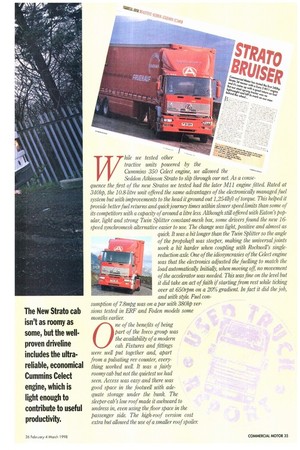
Page 36
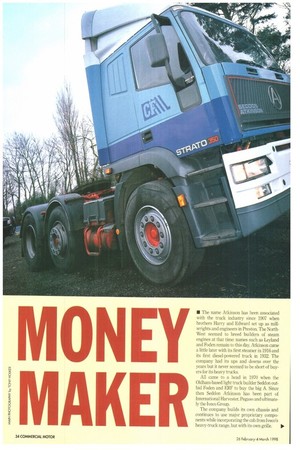
Page 38
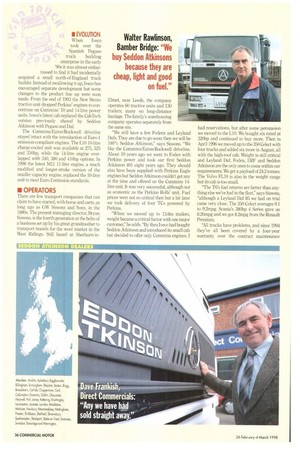
Page 39
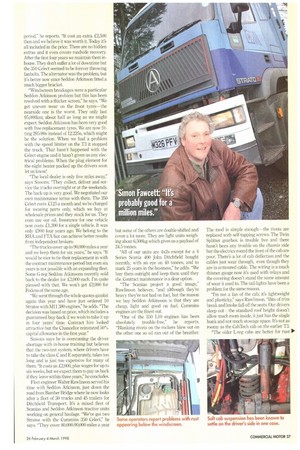
Page 40

Page 41
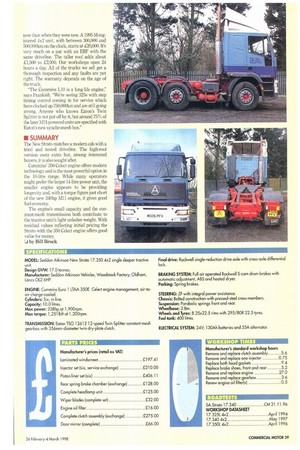
If you've noticed an error in this article please click here to report it so we can fix it.
the wellproven driveline includes the ultrareliable, economical Cummins Celect engine, which is light enough to contribute to useful productivity.
• The name Atkinson has been associated with the truck industry since 1907 when brothers Harry and Edward set up as millwrights and engineers in Preston. The NorthWest seemed to breed builders of steam engines at that time: names such as Leyland and Foden remain to this day. Atkinson came a little later with its first steamer in 1916 and its first diesel-powered truck in 1932. The company had its ups and downs over the years but it never seemed to be short of buyers for its heavy trucks.
All came to a head in 1970 when the Oldham-based light truck builder Seddon outbid Foden and ERF to buy the big A. Since then Seddon Atkinson has been part of International Harvester. Pegaso and ultimately the Iveco Group.
The company builds its own chassis and continues to use major proprietary components while incorporating the cab from New's heavy-truck range, but with its own grille.
6641 44614. While we tested other tractive units powered by the Cummins 350 Celect engine, we allowed the Seddon Atkinson Strato to slip through our net. As a consequence the first of the new Stratos we tested had the later M11 engine fitted. Rated at 340hp, the 10.8-litre unit offered the same advantages of the electronically managed fuel system but with improvements to the head it ground out 1,2541bft of torque. This helped it provide better fuel returns and quick journey times within slower speed limits than some of its competitors with a capacity of around a litre les& Although still offered with Eaton's popular, light and strong Twin Splitter constant-mesh box, some drivers found the new 16speed synchromesh alternative easier to use. The change was light, positive and almost as
quick. It was a bit longer than the Twin Splitter so the angle of the propshaft was steeper, making the universal joints work a bit harder when coupling with Rockwell's single reduction axle One of the idiosyncrasies of the Celect engine was that the electronics adjusted the fuelling to match the load automatically. Initially, when moving off, no movement of the accelerator was needed. This was fine on the level but it did take an act of faith if starting from rest while ticking over at 650rpm on a 20% gradient. In fact it did the job, and with style. Fuel con
sumption of 7.8mpg was on a par with 380hp ver
sions tested in ERF and Foden models some months earlier
0 ne of the benefits of being part of the Iveco group was the availability of a modern cab. Fixtures and fittings were well put together and, apart
from a pulsating rev counter, every thing worked well It was a fairly roomy cab but not the quietest we had seen. Access was easy and there was good space in the footwell with ade quate storage under the bunk. The sleeper-cab's low roof made it awkward to undress in, even using the floor space in the passenger side The high-roof version cost extra but allowed the use of a smaller roof spoiler
II EVOLUTION
When Iveco took over the Spanish Pegaso truck building enterprise in the early '90s it was almost embarrassed to find it had incidentally acquired a small north-of-England truck builder. Instead of swallowing it up, Iveco has encouraged separate development but some changes to the product line up were soon made. From the end of 1993 the New Strato tractive unit dropped Perkins' engines to concentrate on Cummins' 10 and 14-litre power units. Iveco's latest cab replaced the CabTech version previously shared by Seddon Atkinson with Pegaso and Daf.
The Cummins/Eaton/Rockwell driveline stayed intact with the introduction of Euro-1 emission-compliant engines. The L10 10-litre charge-cooled unit was available at 275, 325 and 350hp, while the 14-litre engine overlapped with 340, 380 and 410hp options. In 1996 the latest M1 1 11-litre engine, a much modified and longer-stroke version of the smaller capacity engine, replaced the 10-litre unit to meet Eun)-2 emission standards.
• OPERATORS
There are few transport companies that can claim to have started, with horse and carts, as long ago as GW Sissons and Sons, in the 1880s. The present managing director, Bryan Sissons, is the fourth generation at the helm of a business set up by his great-grandmother to transport teasels for the wool market in the West Ridings. Still based at Sherburn-in Elmet, near Leeds, the company operates 60 tractive units and 130 trailers; many on long-distance haulage. The family's warehousing company operates separately from the same site.
"We still have a few Fodens and Leyland Dafs. They are due to go soon; then we will be 100% Seddon Atkinson," says Sissons. "We like the Cummins/Eaton/Rockwell driveline. About 10 years ago we went to Foden with Perkins power and took our first Seddon Atkinson 401 eight years ago. They should also have been supplied with Perkins Eagle engines but Seddon Atkinson couldn't get any at the time and offered us the Cummins 14litre unit. It was very successful, although not as economic as the Perkins Rolls' unit. Fuel prices were not so critical then but a bit later we took delivery of four TCs powered by Perkins.
"When we moved up to 13.6m trailers, weight became a critical factor with one major customer," he adds. "By then Iveco had bought Seddon Atkinson and introduced its small cab but decided to offer only Cummins engines. I had reservations, but after some persuasion we moved to the Lb. We bought six rated at 320hp and continued to buy more. Then in April 1996 we moved up to the 350 Celect with four trucks and added six more in August, all with the high-roof cab. Weight is still critical and Leyland Daf, Foden, ERF and Seddon Atkinson are the only ones to come within our requirements, We get a payload of 24.2 tonnes. The Volvo FL10 is also in the weight range but its cab is too small.
"The T6's fuel returns are better than anything else we've had in the fleet," says Sissons, "although a Leyland Daf 85 we had on trial came very close. The 350 Celect averages 9.1 to 9.2mpg. Scania's 380hp 4 Series gave us 8.26mpg and we got 8.2mpg from the Renault Premium.
"All trucks have problems, and since 1994 they've all been covered by a four-year warranty over the contract maintenance period." he reports. "It cost an extra £2,500 then and we believe it was worth it Today it all included in the price. There are no hidden extras and it even covers roadside recovery. After the first four years we maintain them inhouse. They don't suffer a lot of downtime but the 350 Celect seemed to be forever throwing fanbelts. The alternator was the problem, but it's better now since Seddon Atkinson fitted a much bigger bracket.
"Windscreen breakages were a particular Seddon Atkinson problem but this has been resolved with a thicker screen," he says. "We get uneven wear on the front tyres—the nearside one is the worst. They only last 95,(00lan; about half as long as we might expect. Seddon Atkinson has been very good with free replacement tyres. We are now fitting 295/80s instead of 12.225s, which might be the solution. When we had a problem with the speed limiter on the T3 it stopped the truck. That hasn't happened with the Celect engine and it hasn't given us any electrical problems. When the plug element for the night heater packed up the drivers soon let us know!
"The local dealer is only five miles away," says Sissons. "They collect, deliver and service the trucks overnight or at the weekends. The back-up is very good. We negotiated our own maintenance terms with them. The 350 Celect costs £125 a month and we're charged for wearing parts only, which we buy at wholesale prices and they stock for us. They even use our oil. Insurance for one vehicle now costs £1,300 for a single vehicle. It was only C900 four years ago. We belong to the RHA and DTA but can achieve better results from independent brokers.
"The trucks cover up to 90,000 miles a year and we keep them for six years," he says. "It would be nice to tie their replacement in with the contract maintenance period but even six years is not possible with an expanding fleet. Some Greg Seddon Atkinsons recently sold back to the dealer for £3,000 each. I'm quite pleased with that. We won't get .C2,000 for Fodens of the same age.
"We went through the whole quotes gambit again this year and have just ordered 10 Stratus with Mll 380 engines," he adds. "The decision was based on price, which includes a guaranteed buy-back if we wish to take it up in four years' time. Contract hire looked attractive but the Chancellor reinstated 50% capital allowance in the first year."
Sist;ons says he is overcoming the driver shortage with in-house training but believes that the two-test system, where drivers have to take the class C and E separately, takes too long and is just too expensive for many of them. "It costs us £2,000, plus wages for up to six weeks, but we expect them to pay us back if they leave within three years," he concludes.
Fleet engineer Walter Rawlinson served his time with Seddon Atkinson, just down the road from Bamber Bridge where he now looks after a fleet of 30 trucks and 45 trailers for Ditchfield Transport. It's a mixed fleet of Scanias and Seddon Atkinson tractive units working on general haulage. "We've got two Straws with the Cummins 350 Celect," he says. "They cover 80,000-90,000 miles a year but sonic of the others are double-shifted and cover a lot more. They are light units weighing about 6,500kg which gives us a payload of 24.5 tonnes.
"All of our units are 4x2s except for a 4 Series Scania 4(X) John Ditchfield bought recently, with an eye on 40 tonnes, and to mark 25 years in the business," he adds. "We buy them outright and keep them until they die. Contract maintenance is a dear option.
"The Scanias project a good image," Rawlinson believes, "and although they're heavy they're not bad on fuel, but the reason we buy Seddon Atkinsons is that they are cheap, light and good on fuel. Cummins engines are the finest out.
"One of the 350 LI 0 engines has been absolutely trouble-free," he reports. "Blanking rivets on the rockers blew out on the other one so oil ran out of the breather. The mod is simple enough— the rivets are replaced with self-tapping screws. The Twin Splitter gearbox is trouble free and there hasn't been any trouble on the chassis side but the electrics round the front of the cab are poor. There's a lot of cab deflection and the cables just wear through, even though they are in armoured cable. The wiring is a much thinner gauge now it's used with relays and the covering doesn't stand the same amount of wear it used to. The tail-lights have been a problem for the same reason.
"I'm not a fan of the cab; it's lightweight and plasticky," says Rawlinson. "Bits of trim break and knobs fall off the seats. Our drivers sleep out— -the standard roof height doesn't allow much room inside, it just has the single bunk and not much stowage space. It's not as roomy as the CabTech cab on the earlier 1'3.
"The older L-reg cabs are better for rust O.
prevention than some of the later ones," he finds, "but the suspension on every one has need
.: ed replacement. Parts such as the rear shockers and front bushes on the torsion bar need to be changed regularly. We had a big problem with the turbo pressure blowing the intake pipe off. Even a strong clip wouldn't hold it in place: we had to use two.
"Alternators fail with the L10 engine but when they stop charging there's no warning light," Rawlinson concludes. "Then if the engine is stopped it won't restart. We haven't had many problems with Celect electrics so when something does go wrong it's a bit of a learning curve for us. Parts prices are good and the back-up from the dealer is average. I would say that Scania is more dedicated."
SR Fawcett Haulage of Preston operates five vehicles on domestic and international work Two Scanias and a Volvo run into Europe while the ERF and Seddon Atkinson work closer to home.
"[bought the Seddon Atkinson about threeand-a-half years ago from a dealer friend because it was available at the time, says owner Simon Fawcett. "I had it on the road within two weeks of ordering it. It's been double-shifted all its life. It's covered 500,000 miles but the engine has never had the rocker cover off. Cummins improved the head and the pistons on this engine—it's probably gxxxi for a million miles.
"At the time Celect was new to Seddon Atkinson and we had to replace a couple of sensors but little has gone wrong with it since," he reports. "It seems to get better the older it gets. The truck runs across to Yorkshire in the traffic over the M62 during the day and trunks up and down the M6 at night. Fuel consumption is nudging 8.0mpg.
"We've just had to change the tacho and the heater motor has been replaced," Fawcett adds. "The front cab mountings are a bit soft, which allowed it to settle on the driver's side. Now the spring has a stronger bias. Clutches
have been the big problem— it's had three. The power output is high but it's only got a 14-inch diameter clutch. We get a bigger mileage from the other vehicles. We put a vertical stack on it and replaced the two-piece propshaft with a one-piece. There's less vibration and the take-up is much smoother. We're used to the Twin Splitter but it is a problem when we take on casuals at the weekend.
"It has the standard cab but it's never been slept in" says Fawcett. "It takes a lot to get a driver out of a Scania cab but I don't think the same could be said for this one. There is slight rust under the windscreen seal but the cab is covered by a long anti-rust warranty. Iveco bits are a reasonable price and the chassis parts are much the same as ERF. We still buy on hire purchase. [have looked at contract hire but I am of the old school and like to own the truck at the end of the day. I don't buy extra an warranty unless it's a truck I don't have any experience of.
"When I have paid for the Strato, later this year, I will see how it is going and will probably replace it with a new Seddon Atkinson with the M1 1 380," he adds. "Residuals are not very high but we paid less than £50,000 for it. My Volvo FH 420 cost £20,000 more."
• DEALERS
Independent dealer Geoff Sipson Commercials, based about half a mile from Junction 3 on the M6, always has a good mix of 6x2 and 4x2 tractive units on offer.
"I don't think we've ever had a New Strato, with the 10-litre engine rated at 350hp," says Sipson. "It's the most powerful LIO engine Cummins produced but, like most British trucks with small engines, there's not a lot of demand for them. There are still a lot of operators who like the Cummins/Eaton/Rockwell driveline combination but most will be looking for the larger 14-litre engine to go with the tall cab for international work. "I think it is a well designed cab," he adds. "It has a lot of space inside. If you can find a New Strato, a 1995 4x2 model on an M-reg should fetch around £17,000 so they're good value. You'd have to pay around £30,000 for a Scania of the same age."
Dave Frankish is sales manager for Seddon Atkinson franchised dealer Direct Commercials of Brigg, North Lincs.
"We've been actively selling used trucks for the past three to four years," he says, "and now sell more of them than we do new-90% of new registrations in this area are for tractive units and, although we sell to operators from all over the country, that broadly reflects the mix of used vehicles we have for sale.
"Normally we expect to have 10 to 15 vehicles in stock," says Frankish. "We don't see enough New Stratos with the Cummins L10 350 Celect engine. We sold quite a few when they were new but not one of them has been traded back in yet. Those we have picked up we bought in to sell on.
"Seddon Atkinson's annual registrations are fewer than many manufacturers so there is only a limited number available," he adds. "With the 350 Celect it was new technology which has been carried over to the later Mll engine. There were one or two that had problems with the electronic control in the early days but any faults were sorted out very quickly and overall the 350 Celect has been a reliable engine. Any we have had sold straight away—we've never had one that stuck.
"We still have customers who ask for the earlier T3 cab but the Iveco cab is proving to be better," he reports. "We don't get much demand for the standard roof height: most customers want the high-roof version. In the used market they carry a higher premium
now than when they were new. A 1995 M-registered 4x2 unit, with between 300,000 and 500,000km on the clock, starts at £20,000. Ifs very much on a par with an ERF with the same driveline. The taller roof adds about £1,500 to £2,000. Our workshops open 24 hours a day. All of the trucks we sell get a thorough inspection and any faults are put right. The warranty depends on the age of the truck.
"The Cummins L10 is a long-life engine," says Frankish. "We're seeing 325s with step timing control coming in for service which have clocked up 750,000km and are still going strong. Anyone who knows Eaton's Twin Splitter is not put off by it, but around 75% of the later MU-powered units are specified with Eaton's new synchromesh box."
• SUMMARY
The New Strato matches a modern cab with a tried and tested driveline. The high-roof version costs extra but, among interested buyers, it is also sought after.
Cummins' 350 C,elect engine offers modern technology and is the most powerful option in the 10-litre range. While many operators might prefer the larger 14-litre power unit, the smaller engine appears to be providing longevity and, with a torque figure just short of the new 340hp M11 engine, it gives good fuel economy.
The engine's small rapacity and the constant-mesh transmission both contribute to the tractive unit's light unladen weight With residual values reflecting initial pricing the Strato with the 350 Celect engine offers good value for money.
Li by Bill Brock
SPECIFICATIONS
MODEL: Seddon Atkinson New Strato 173504x2 single sleeper tractive unit.
Design GVW: 1 7.0 tonnes.
Manufacturer: Seddon Atkinson Vehicles, Woodstock Factory, Oldham, Lancs 0L2 6HP, Final drive: Rockwell single-reduction drive axle with cross-axle differential lock.
ENGINE: Cummins Euro 1 LTAA 350E. Ce1ect engine management, oir-to
ar charge-cooled.
Cylinders: Six, in line. Capacity: 10.0 litres. Max power: 338hp at 1,900rpm.
Max torque: 1,251 lbft at 1,200rpm. BRAKING SYSTEM: Full air operated Rockwell S-cam drum brakes with automatic adjustment, ABS and heated dryer. Parking: Spring brakes.
STEERING: ZF with integral power assistance. Chassis: Bolted construction with pressed-steel cross-members. Suspension: Parabolic springs front and rear.
Wheelbase: 3.8m.
Wheels and Tyres: 8.25x22.5 rims with 295/80R 22.5 tyres. Fuel tank: 400 litres.
TRANSMISSION: Eaton ISO 1 2612 12-speed Twin Splitter constant-mesh gearbox with 356mm-diameter twin dry-plate clutch.
ELECTRICAL SYSTEM: 24V; 130Ah batteries and 55A alternator.
PARTS PRICES
Manufacturer's prices (retail ex VAT) Laminated windscreen £197.41 Injector set (six, service exchange) £210.00 Piston liner set (six) £406.11 Rear spring brake chamber (exchange) £128.00 Complete headlamp unit £125.00 Wiper blades (complete set) £32.00 Engine oil filter £16.00 Complete clutch assembly (exchange) £275.00 Door mirror (complete) £66.00
WORKSHOP TIMES
Manufacturer's standard workshop hours Remove and replace clutch assembly 5.6 Remove and replace one injector 0.75 Replace both head gaskets 9.4 Replace brake shoes, front and rear 5.2 Remove and replace engine 27.0 Remove and replace gearbox 3.6 Renew engine oil filter(s) 0.5
ROADTESTS
SA Strato 17.340 CM21.11.96 WORKSHOP DATASHEET 17 325L 4x2 April 1994 17.3404x2 May 1 997 17.350L 4x2 April 1996




















































































































